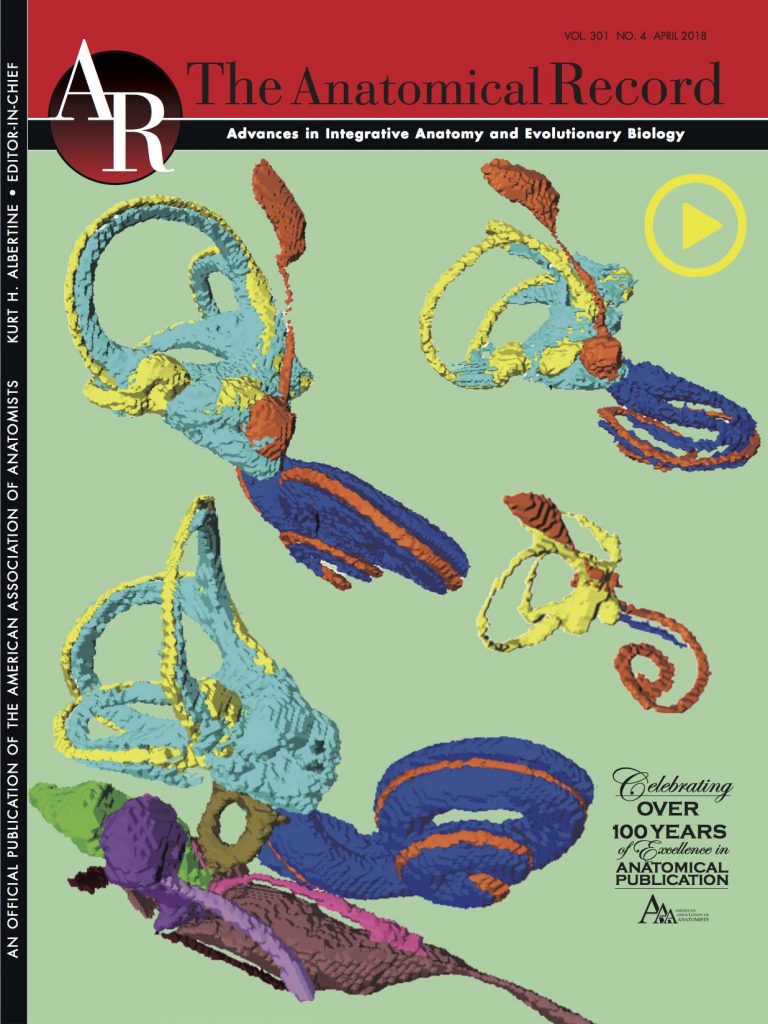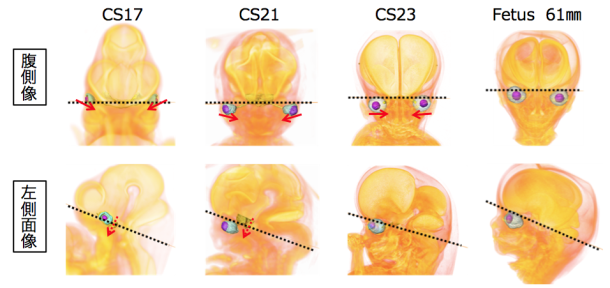
 佐賀県立九州シンクロトロン光研究センターに行きました。(2018.0612
佐賀県立九州シンクロトロン光研究センターに行きました。(2018.0612
位相CT撮像データからイメージ作成を行う手法を共同研究者の米山先生から習いました。
|
||||
|
金橋君が2018年度日本先天異常学会奨励賞を受賞しました。おめでとうございます。 Kanahashi T, Yamada S, Tanaka M, Hirose A, Uwabe C, Kose K, Yoneyama A, Takeda T, Takakuwa T, A novel strategy to reveal the latent abnormalities in human embryonic stages from a large embryo collection, Anatomical Record, 299,8-24,2016 10.1002/ar.23281(概要), *299(1),2016の表紙に採用されました。DOI: 10.1002/ar.23206 (cover page) 石川さんの論文がAnatmial Recordに掲載されました。 内耳のうち膜迷路、骨迷路の間にあるperiotic spaceの形成に着眼したユニークな論文です。図が表紙に採用されました!!
32. Ishikawa A, Ohtsuki S, Yamada S, Uwabe C, Imai H, Matsuda T, Takakuwa T. Formation of the periotic space during the early fetal period in humans, Anat Rec, 2018, 301(4);563-570, 10.1002/ar.23764, 10.1002/ar.23657 Abstract The inner ear is a very complicated structure, composed of a bony labyrinth (otic capsule; OC), membranous labyrinth, with a space between them, named the periotic labyrinth or periotic space. We investigated how periotic tissue fluid spaces covered the membranous labyrinth three-dimensionally, leading to formation of the periotic labyrinth encapsulated in the OC during human fetal development. Digital data sets from magnetic resonance images and phase-contrast X-ray tomography images of 24 inner ear organs from 24 human fetuses from the Kyoto Collection (fetuses in trimesters 1 and 2; crown—rump length: 14.4–197 mm) were analyzed. The membranous labyrinth was morphologically differentiated in samples at the end of the embryonic period (Carnegie stage 23), and had grown linearly to more than eight times in size during the observation period. The periotic space was first detected at the 35-mm samples, around the vestibule and basal turn of the cochlea, which elongated rapidly to the tip of the cochlea and semicircular ducts, successively, and almost covered the membranous labyrinth at the 115-mm CRL stage or later. In those samples, several ossification centers were detected around the space. This article thus demonstrated that formation of the membranous labyrinth, periotic space (labyrinth), and ossification of the OC occurs successively, according to an intricate timetable. 多元計算解剖学第4回国際シンポジウム(The 4th International Symposium on Multidisciplinary Computational Anatomy)で発表しました。(3/2-2/3, 東京大学) A02-KB107 Analysis of Central Nervous System and Skeletal System During Human Early-fetal Period Based on Multidisciplinary Computational Anatomy -Progress Overview FY 2017- (PI:Tetsuya Takakuwa) 2017年度; 修士論文発表会が行われました(2018.0207; 杉浦ホール) ヒト胚子期における腎盂形成の三次元的解析 石山 華 【背景】腎盂の発生はCarnegie Stage(CS)14頃に始まる。この発生過程については、組織切片を用いた平面的な研究が主であり、CSに沿った報告としてShikinamiの報告がある。 37. Ishiyama H, Ishikawa A, Imai H, Matsuda T, Yoneyama A, Yamada S, Takakuwa T. Spatial relationship between the metanephros and adjacent organs according to the Carnegie stage of development. Anat Rec (Hoboken) 2019. 302, 1887-2104. DOI: 10.1002/ar.24103 34. Ishiyama H, Ishikawa A, Kitazawa H, Fujii S, Matsubayashi J, Yamada S, Takakuwa T, Branching morphogenesis of the urinary collecting system in the human embryonic metanephros, PLoS One 13(9): e0203623. doi: 10.1371/journal.pone.0203623 大槻さんの卒論(胎児期の中耳の形成)が The Anatomical Recordに掲載されました。 中耳の耳小骨が骨化する過程、鼓室という空隙で覆われていく様子が立体的に示されました。
31. Ohtsuki S, Ishikawa A, Yamada S, Imai H, Matsuda T, Takakuwa T, Morphogenesis of the middle ear during fetal development as observed via magnetic resonance imaging. Anat Rec 2018, 301, 757-764, doi: 10.1002/ar.23760 ABSTRACTRecently, our research group has utilized serial histological sections to investigate the morphogenesis of the middle ear, which corresponds to the period of middle ear ossicle (MEO) cartilage formation. However, research regarding middle ear development during the post-embryonic period has been limited. In the present study, we investigated morphogenesis of the middle ear in human fetuses with a crown-rump length (CRL) between 37 and 197 mm using high-resolution magnetic resonance imaging (MRI). Our findings indicated that the morphology of the MEOs is similar during fetal development and adulthood; further, growth of the MEOs nearly ceases once a CRL of 150 mm is attained. In each MEO, ossification spreads from a single center. The malleus and Meckel’s cartilage could be discriminated in samples exhibiting a CRL of 145 mm based on differences in MRI signal intensity. In samples with a CRL of 86 mm, the tympanic cavity (TC) appeared as a thin yet distinct structure attached to the external auditory meatus at the convex surface. Only the handle of the malleus was covered by the TC, while the incus and stapes contacted the cavity at the region of articulation between the two ossicles only, even after a CRL of 145 mm had been attained. Thus, although the TC increased in both diameter and thickness, coverage did not extend across all three MEOs during the observation period. These data are expected to provide a useful standard for morphogenesis and may aid researchers in distinguishing between normal and abnormal development. Anat Rec, 301:757–764, 2018. 2017年度;卒業研究発表会が行われました(杉浦ホール)。
ヒト胚子期における後頸部の膨隆の組織学的検討 大賀 彩子 ヒト胚子期における肋骨と胸郭の三次元的解析 奥野 香澄 (石津研) 後腎における腎小体形成の組織学的検討 北沢 遥 ヒト胚子期~胎児期初期における肩甲骨の形態形成 坂本 梨乃 生理的臍帯ヘルニアの還納過程及び還納後の小腸の位置固定 長田 明香里
白石直樹くんの博士審査会が行われました。 (11月27日18時 高井ホール於) Morphology and morphometry of the human embryonic brain: A three-dimensional analysis (ヒト胚子期における脳の三次元形態計測学的解析) (NeuroImage, 2015, 115, 96-103、掲載済み) ヒトの発生時期のうち、組織と器官を急速に形成する器官形成期は先天異常の発生の可能性が高い時期であり解析に重要な時期である。京都大学大学院医学研究科附属先天異常標本解析センターが保有する外見上、傷や先天異常がないヒト胚子群から、2.35TのMR顕微鏡で撮像されたCarnegie Stage(CS)13~23のヒト胚子立体画像を用いて、脳実質と脳室の形態形成について立体化像の形態変化の詳細な観察と定量学的な検討を加えた。脳実質の厚みの変化を色彩表示する方法、及び内外から大脳壁の厚さ分を削り、残った部分を肥厚部として描出するという方法を用いて可視化した。脳実質の体積はCS13からCS23間に164.4倍に形態変化を伴いながら著しく増大した。前脳、中脳、菱脳の体積もそれぞれ増大した。小脳はCS20に初めて観察され、菱脳に対する小脳の体積比はCS20の約7.2%から、CS23では12.8%と大きく増大していた。胚子体積に対する脳実質体積比はCS15からCS23の期間で11.6〜15.5%と大きな変化はなかった。前脳部の肥厚部はCS16から見られ、その解剖学的位置は大脳基底核、視床、内包と合致した。CS17以降には神経核が発達し、特に前脳部の大脳基底核付近、菱脳部の基板や小脳部が不均一に肥厚していくことがわかった。CS20になると前脳部や菱脳部で厚さの不均一性が目立ち、CS23では著明であった。これらの不均一な肥厚が、胚子期における脳の複雑な屈折や進展に影響を及ぼしている可能性がある。今回、提示した手法は神経核の発達を観察する上で非常に優れた方法であり、胎児期の脳発達の観察、解析に応用可能と考えられる。以上の研究は器官形成期のヒト脳の発生の解明に貢献し人体発生学、脳発生学や胎児診断に寄与するところが多い。
大坂さんの修論の前半部がAnatomical Recordに掲載されました。 頭部・顔面形成にともなう眼の位置変化を胚子期から胎児期初期にかけて解析しました。
Osaka M, Ishikawa A, Yamada S, Uwabe C, Imai H, Matsuda T, Yoneyama A, Takeda T, Takakuwa T, Positional changes of the ocular organs during craniofacial development, Anatomical Record, 300(12), 2107–2114, 2017 DOI: 10.1002/ar.23588  ABSTRACTThe present study aimed to describe the positional changes of the ocular organs during craniofacial development; moreover, we examined the relationships among the ocular organs and other internal structures. To do this, we traced the positions of the ocular organs in 56 human early fetal samples at different stages of development using high-resolution magnetic resonance imaging and phase-contrast X-ray computed tomography. The eyes were located on the lateral side in the ventral view at Carnegie stage (CS) 16, and then changed their positions medially during development. The eyes remained in the neurocranium until CS17. However, the eyes changed their positions medially and caudally in the viscerocranium after CS18. The positional relationship between the eyes and pituitary gland changed in the lateral view as development progressed. Specifically, they were close to each other at CS17, but moved apart during the later stages of development. These positional changes were also demonstrated quantitatively with morphometric analyses. Based on the present data, the positional changes of the eyes can be categorized into phases, as follows: Phase 1, dramatic positional changes (early fetal period until CS23); and Phase 2, mild positional changes (stabilized; early fetal period after CS23). Notably, all absolute lengths measured in the present study linearly increased as the crown-rump length increased irrespective of the phase, while features of the measured angles and ratios differentially changed in Phases 1 and 2. The present data may help improve our understanding of both the normal and abnormal development of the ocular organs and craniofacial area. |
||||